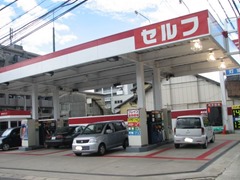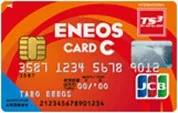Gas Stations in Japan - How to fill up

If you own a car or for whatever other reason need to drive in Japan, then you have no doubt become acquainted with the Japanese gas station. Originally, Japanese gas stations were full-service only, with a few attendants waiting around for customers and then providing their service energetically with a smile. Self-service gas stations are becoming more and more common these days.
Full-service gas stations

If you go to a traditional gas station, you will sometimes be greeted by one or more attendants who will guide into position near an available pump with shouts of “Oorai, oorai, sutoppu!” (Alright, Alright, Stop!)
If you forget to turn off your car once you’ve come to a stop, they will politely ask you to cut power to your engine.
One of the attendants will then inquire what type of gas you need and how much to put in.
Attendant: “Mantan desuka?” (Would you like a full tank of gas?)
Driver: “Regular mantan de onegai shimasu.”(Please give me a full tank of regular gas.)
*If you prefer or require high-octane gasoline, you would respond:
Driver: “Haioku mantan de onegai shimasu.” (Please give me a full tank of High Octane (premium) gas)
*If you wish to get only 2,000yen’s worth of gasoline:
Driver: “Regular nisen-en bun onegai shimasu.” (2,000yen’s worth of regular gas please.)
Then the attendant may ask you how you would like pay.
Attendant: “Genkin desuka?” (Will you pay with cash?)
If you’re paying with cash:
Driver: “Hai, genkin desu.” (Yes, with cash.)
If you’re paying with credit card:
Driver: “Iya, kurejitto kaado de.” (No, with credit card.)
The attendant will then put gas in your car’s tank per whatever instructions you gave. Typically, another attendant will offer to clean all of your windows and mirrors while the tank is being filled. You may be handed a towel so that you can wipe your front windshield from inside of your car.
They may also offer to empty your ashtray.
Attendant: “Haizara wa ii desuka?” (How is your ashtray?)
Once he has completed filling your tank, the attendant will take your payment.
The attendant will probably then ask you which way you are going when you exit the gas station.
Attendant:”Dochira he ikimasuka?”(Which way are you going?)
Driver: “Hidari desu.” (Left) or “Migi desu.” (Right)
Attendant: “Ryoukai desu! Arigatou gozaimasu!” (Understood. Thank you!)
Self-service gas stations
Self-service gas stations are indicated by the セルフ (serufu) signs that you see pictured below.
Self-service gas stations, similar to gas stations in other countries, are where you pull up next to an available gas pump. The pump will have a screen with instructions for purchasing gas and selecting which type you need. Typically, there is an option for English-language menus and instructions. So, look for that if it’s required.
When pulling into a Self-service gas station, there will usually be an attendant or two. Much like at the full-service gas station, their job is to guide the cars into position and make sure everyone takes turns.
When you get to the pump turn off your car. At the pump, there will be 3 pump nozzles. The red is “Regular,” the yellow is “High Octane,” and the green is “Diesel.”
Before pulling out a pump nozzle, be sure to touch the static electricity removal pad then insert the nozzle into your gas tank. Hold down the trigger filling up the tank until the trigger becomes loose, meaning your gas tank is full. Do not try to top off your gas tank. Once the trigger becomes loose, touch the static electricity removal pad again and return the nozzle to its place of origin.
Another thing to note about self-service stations is that they are generally cheaper than their full-service cousins.



Gas Cards

If you pay for gas at a station with the credit card issued by that company (Eneos, Shell, Mobil, Cosmo, etc.), you will often receive a discount of 2-3%. Alternatively, some cards give you points every time you fill your car and you can use those points to purchase items at the service station or else get a discount on the price of gas. Please refer to your specific card’s guidelines for details.

- Rental Apartments & Houses in Tokyo
- Listings of popular and luxurious rental apartments, condominiums, and houses designed with expats in mind.

- Apartments & Houses for Sale in Tokyo
- Listings of apartments, condominiums, and houses available for purchase in Tokyo.



















